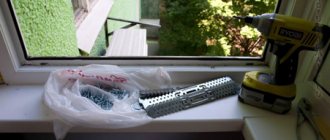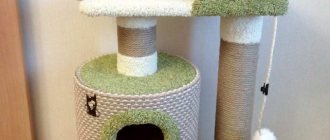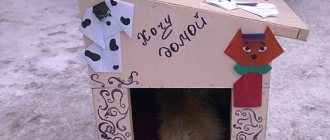Types of cat houses
Here is a gallery of ideas from home craftsmen:
You can explore the range of cat houses on the market and choose the best design for your pet.
Most often, cat owners choose the following models:
- Various beds. Suitable for calm animals that spend most of their time observing.
- Booth house. Suitable for pets who like to spend time in solitude. It's easy to make from a cardboard box.
- Hammock bed. Can be located in any free place - under a chair, stairs, etc.
- Game complexes. Suitable for families with two or more cats. They may consist of several houses, passages, scratching posts and hammocks. Their parameters and content depend on the desires and capabilities of the owner.
Two-story cardboard house
You will need: door and window templates (prepare and cut out first), two identical strong cardboard boxes (the larger the cat, the larger the box needed), pencil, ruler, stationery knife, hot glue.
Performance:
- First, decide on the scale, draw and cut out door and window templates. Attach them to the boxes that will make up the first and second floors, and trace the contours of the templates. Take a utility knife and use the drawn lines to make an opening for the doors and windows.
- Take the first box and cut off the two top flaps, located not opposite each other, but next to each other. Take the second box and cut the flaps in the same places, but from the bottom. After this, glue the doors to each other in each box. When the roof is made, you will need to connect them together and glue them.
- Making a roof. To do this, draw triangles on the two smaller flaps at the top, located opposite each other, so that the two remaining parts of the flap can be bent forward. Lightly draw a knife along the drawn line and bend it forward. Then we glue them from below to two adjacent sashes, thus creating a roof. Now you can connect both boxes together.
- The house is ready! Call the cat to evaluate the work. For greater comfort, you can lay a rug or pillow inside the house.
We create a house for a cat. What do you need to know?
Dimensions. Cardboard houses must correspond to the parameters of the animals. For a pet with average parameters, a cubic design will be suitable, the width of which will be about 40 centimeters. A hole 15–20 centimeters wide is sufficient for entry. If the entrance is very wide, the animal will feel unprotected. The basic rule is that the pet must fit freely in the house, lying on its side.
Important! Siamese and Bengal cats love to sit on their hind legs. It is better for them to make a cardboard house with their own hands in the form of a wigwam. Its height should be at least 60 - 70 centimeters.
Benefits of a self-made cardboard house:
- Saving money.
- A self-created product will be in harmony with the interior of the room.
- An additional reason to please your pet.
- Minimum investment of time and effort.
- There is no need to throw away empty boxes.
INTERESTING TO LEARN: How to trim a cat’s claws correctly
Design nuances
Despite the simplicity of the solution, before you start decorating a house out of a box with your own hands, you should analyze the character of the cat. Things to consider when designing:
- How she prefers to spend her free time - watching others, actively playing or sleeping around the clock.
- Does she have a bad habit of tearing up furniture?
- Does the cat like to hunt and track down enemies?
An analysis of your pet's personality traits will allow you to design a house that best suits its needs. The design may contain:
For those who like to contemplate their surroundings, it is better to make a two-tier house with a couch on top with your own hands. This will allow the cat to always be aware of events.
Avid hunters and caring mothers will need a second passage through which they can observe a potential enemy.
Active cats will appreciate a house out of a box, complete with exercise devices. It’s not difficult to make plywood posts with your own hands that are comfortable to jump on.
Installing a scratching post will help maintain the aesthetic appearance of upholstered furniture. To do this, the post, the function of which can be performed by a metal or PVC pipe, should be wrapped with jute rope and securely fixed near the box house. An important condition is convenient access from all sides of the structure.
The dimensions of the box house must correspond to the size of the cat itself. For a medium-sized guest, it is optimal to make a structure in the shape of a cube with a side of 40 cm. The width of the entrance is from 15 to 20 cm. Smaller or larger individuals need to adjust the dimensions of the house out of the box. The main condition is that the animal must fit freely on its side. In any case, you should carefully consider your login options. If the hole is too large, the cat will feel unprotected, the main thing is that it fits through it without problems.
Advice! The position on the hind legs is one of the favorites of Bengal and Siamese cats. Therefore, it is preferable for them to make a kind of wigwam with their own hands, the height of which will be within 60-70 cm.
Materials and tools for creating a cardboard house:
- Cardboard box. This could be packaging from household appliances, a box, etc.
- Soft and dense upholstery material. Carpet is best.
- Water-repellent interior lining.
- Wide tape.
- Glue without foreign odors.
- Stationery knife, pencil, ruler.
Owners don’t always understand how to make a house for a cat out of a box. There are no big difficulties in this. It is necessary to select materials and strictly follow the instructions.
Fastening and covering
A cardboard cat house is often made from a simple box, leaving it undecorated and unlined. But caring owners know that it is better to cover the product with material so that the animal is more comfortable and cozy in its new home, and it fits perfectly into the home interior.
To cover the structure, choose colored cardboard, self-adhesive paper, wallpaper, soft but dense material with water-repellent properties, safe for your pet and non-toxic; carpet would be ideal. It is better not to use fabric that is too bright and stiff; it will quickly fade and begin to put pressure on the cardboard, gradually worsening its supporting functions.
We create a house for the cat ourselves. Step-by-step instruction
Option No 1
- We cut a hole of the required size in one of the walls of the cardboard box. This will be the entrance to the house. You should not make a very large hole, otherwise the cat will feel uncomfortable being inside.
- We fix the folding sides of the box with tape.
- We cut out parts from waterproofing material to finish each wall of the box. Glue it.
- We cut out an additional waterproofing piece for the bottom. The house must be reliably insulated from below.
- We cover the outside of the cardboard house for cats with carpet. You can use thick fabric, wallpaper, fur. But practice shows that cats get used to a carpet house faster. In addition, the animal can sharpen its claws on the carpet and be discouraged from furniture.
- Leave the house for several days until the glue is completely dry and aired.
- We cover the inside of the structure with a blanket or place a small pillow.
Option No 2
- We cut out padding from padding polyester to the bottom according to the dimensions.
- We cover the bottom with synthetic padding. Can be replaced with foam rubber.
- On the side of the cardboard box we cut out a round or oval entrance in accordance with the cat’s parameters.
- On the other side we cut out a small hole in the form of a window. We cover it with an insect net (if the house will be used outside). A window is necessary to ensure air circulation in the house.
- We close the foldable flaps of the cardboard box and attach them with tape.
- We decorate the top of the house with thick fabric or wallpaper.
Option No 3
Suitable for Siamese and Bengal cats.
INTERESTING TO KNOW: Why cats and cats wag their tails
- We cut out rectangles from a cardboard box measuring 50 x 40 centimeters. For Siamese and Bengal cats, cut out pieces measuring 50 x 60 cm. A total of three rectangles are needed. This will be the base and two side parts.
- We cover the rectangles inside and outside with upholstery fabric.
- We connect the two parts to each other at an angle of 60 degrees. We attach the third part to them. We fasten the entire structure with PVA glue. We get a house in the form of a triangular prism.
- We cover the bottom of the house with padding polyester or other soft bedding.
- We install the house near the radiator to make the cat warm and cozy.
Another variation:
Option No. 4
House made of cardboard rings.
We cut out rings from cardboard with a gradual decrease in diameter, as shown in the photo. Then we glue them together. It turns out to be a creative house - a cocoon. Judging by the video, the cat likes it)
Ready-made diagrams - drawings and dimensions
Now we want to show you several ready-made diagrams on how to make a house for cats out of a box.
House made from a box and a T-shirt
In order to make such a house, you will need to take a cardboard box of a suitable size, as well as an unnecessary T-shirt, 50 cm pieces of wire and tape. Cross the wire sections and secure the contact area with tape. The ends of the wire should also be wrapped with tape to prevent the cat from chewing them. You will get two arcs that will help adjust the height of the cat’s home.
The base will be a box with low sides. We insert the arcs into it and fix it at the bottom with glue. We do this carefully so that sharp edges do not peek out. We stretch a T-shirt over this blank. For aesthetics, some places can be torn off and sewn up. You need to pull the T-shirt so that the neck is like the entrance to the house.
Don’t forget that this version of a box house for cats is the fastest to make, but the downside is that it is not durable.
Multi-tiered house made from a large box
Cats are very curious and careful. To create the most interesting home, add a few interesting details when creating a house. So, a great idea would be to create a multi-tiered house. The main difference from one-story houses is that the structure will have to be strengthened. To do this, you can use a plastic pipe that will pass through all floors. The base must be very strong so that, if necessary, the house can support several cats at once.
You will need:
- Chipboard sheet.
- Large cardboard box.
- Glue (ideally a glue gun).
- Rope (or jute).
- Plastic pipe.
Instructions:
- Arm yourself with a jigsaw and cut out the base for the house from a sheet of chipboard with a small allowance for fasteners.
- Cut holes for the pipe in the house, and secure the pipe to the sheet. This can be done using a glue gun or special corners for chipboard with self-tapping screws.
- Sheathe the resulting structure from the inside with material with moisture-repellent properties.
- At the allowance, install another pipe made of plastic or cardboard.
- Using hot glue, wrap the pipe with rope or jute. You will get a chic, and most importantly, environmentally friendly scratching post.
Features of house decor
We decorate self-made homes for pets like this:
- We cover it with fabric, which we select in accordance with the overall style of the interior.
- Cover with white paper. Then we decorate it to our liking.
- We wallpaper it to match the walls of the apartment.
- We decorate the house with soft toys in the form of mice, birds, other animals and insects.
You can install a scratching post next to the house so that your pet can sharpen its claws. This way you will protect your furniture from damage.
Conclusion
Building a cat house with your own hands is a simple and very interesting process. Unfortunately, cardboard houses are completely short-lived and not suitable as an outdoor home, but they are easy to start with.
Important!
The structure should not have any unpleasant odors. It involves ensuring convenience and comfort for the pet, so it is important to try to take into account all the nuances.
Before constructing a house for a cat, you should carefully observe your pet; with its character and behavior, it will tell you which model and material to give preference to. If you build a house according to its needs, the cat will often spend time in it, as these animals value privacy and their own personal space.
Precautionary measures:
- It is prohibited to use a stapler as a fixing material. Cats sometimes chew cardboard. A pet may accidentally swallow a stapler or injure its mucous membrane.
- Do not use adhesives with a strong odor. PVA glue is optimal. It does not emit strong odors and dries quickly.
- It is forbidden to use boxes found on the street. Stray cats and dogs could live in them. There is no guarantee that they were healthy.
- Tight boxes should not be used. The cat will want to stay awake in a place where it is uncomfortable.
- It is forbidden to hang a cardboard cat house. The product may fall and the animal may be injured.
A self-built cardboard house for a cat will save money on the family budget and the nerves of the owners. After all, a pet will not look for a place to lie in the wrong place.
The simplest house out of a box
Use a large compass to mark the round entrance on the box and cut it out with a stationery knife. The joints of the new cat house are further strengthened by gluing tape on the sides. This will allow the product to deform less and extend its service life. Carpet or dense material is cut out, having previously measured the bottom and walls. It is then secured from the inside using glue or a glue stapler. All joints are also covered with fabric.
The entrance to the home can be made in the shape of an arch, and also a small round window can be made on the roof for additional lighting. It is advisable to secure the outside of the cardboard structure with tape at the joints and trim it with decorative fabric or unnecessary wallpaper, using a heat gun or regular PVA glue. Inside, the floor is usually covered with an old blanket or sweater and a small flat pillow is placed. Before showing the pet new apartments, they are dried in the sun for several days.
Scratching post options
In addition to the most common scratching posts for cats, you can make simple but original analogues. So, it is permissible to make a scratching post in the form of a picture. To do this you will need a simple piece of plywood (rectangular) and carpet.
When there is a lot of space, you can afford to build a large house
The carpet is fixed to the board using nails and a hammer. The corners of the fabric should be hidden on the back. They even attach a mini hanger. Then the finished painting is hung on the wall in the corridor or room. It should hang at the height of the pet. This refers to the cat's height at the withers, and not from the floor to the tips of his ears.
VIDEO: How to build a house for a cat with your own hands?
Cat's house
Do it yourself
For many masters, such a process will only bring pleasure. And as for the fact that the house may not work out, that’s also not scary. But it will be made with love and with your own hands.
Required Tools
- 5-6 large cardboard boxes.
- Scissors, craft knife or chisel.
- Ruler.
- Packing tape.
- Pencil.
- A piece of fabric 45*45 cm.
- A strip of fabric or scraps measuring 132*15 cm.
- Fabric glue.
- Dried catnip.
Break the boxes down into large, flat pieces, then measure out the size you need and cut the cardboard into equal-width strips. The long sides should run along the corrugations.
Bruce Willis will spend a holiday with his wife after how long he stayed with Demi Moore
Druid flower horoscope for 2021 by date of birth
Handsome, happy birthday: Alena Sviridova congratulated her son on his 17th birthday











